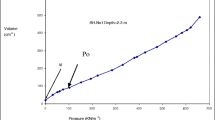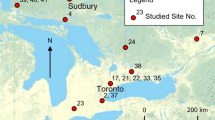Abstract
The paper presents a numerical finite difference model of self-boring pressuremeter test (SBPM) using FLAC software. Different cavity expansion theories in sand have been compared to the results of numerical analyses carried out in this study. Limit pressure is believed to be used as a key parameter for the estimation of soil parameters from pressuremeter tests. In practice, SBPM tests are conducted up to 10–15% cavity strains, and the strain level associated with the limit pressure state is not reached. Therefore, determination of limit pressure usually needs extrapolation. In this paper, the authors suggest to use cavity pressure at 10% strain (P 10) for the interpretation of in situ horizontal stress from SBPM test rather than limit pressure. For this purpose, more than 5000 numerical analyses of SBPM are carried out, and cavity pressures associated with 10% strain are deduced. Based on these extensive numbers of numerical analyses, a new relationship is established with the aid of genetic algorithm which correlates P 10 to soil parameters. The estimated values of P 10 from the proposed relationship are compared to a large database of measured ones obtained from laboratory and field results available in the literature. It was shown that the proposed relationship gives satisfactory predictions of P 10. A chart was established for deduction of the in situ horizontal stress using the proposed relationship. This method can be used as a complement to liftoff method which is not reliable for estimation of the in situ horizontal stress when soil disturbance occurs at cavity wall.

















Similar content being viewed by others
Abbreviations
- A :
-
Shear modulus coefficient
- C :
-
Correction factor for critical friction angle
- D :
-
Diameter of the cavity (pressuremeter)
- F.F:
-
Fitness function
- G :
-
Shear modulus
- L :
-
Length of the flexible part of probe
- P 10 :
-
Cavity pressure at 10% cavity strain
- \( P_{10}^{\prime } \) :
-
Computed cavity pressure at 10% cavity strain
- \( r_{0} \) :
-
Radius of the cavity (pressuremeter)
- \( r_{\text{m}} \) :
-
Radius of the grid in the numerical model
- S :
-
Slope of the cavity pressure plotted against cavity strain on a logarithmic scale
- \( \phi \) :
-
Friction angle
- \( \phi_{\text{cv}} \) :
-
Critical friction angle
- \( \varPsi \) :
-
Dilation angle
- \( \varPsi_{\hbox{max} } \) :
-
Peak dilation angle
- \( \sigma_{\text{h0}} \) :
-
In situ total horizontal stress
- \( \sigma_{\text{v0}} \) :
-
In situ total vertical stress
- \( \mu \) :
-
Poisson’s ratio
References
Bahar R (1992) Analyse numérique de l’essai pressiométrique: application à l’identification de paramètres de comportement des sols. Thèse de doctorat. Ecole Centrale de Lyon, France
Bellotti R, Bruzzi G, Ghionna V (1982) Design, construction and use of a calibration chamber. In: Proceedings of the 2nd European symposium on penetration Testing, Amsterdam, vol 2. A.A. Balkema, Rotterdam, pp 439–446
Bellotti R, Crippa V, Ghionna VN, Jamiolkowski M, Robertson PK (1987) Self-boring pressuremeter in pluvially deposited sands. Final technical report to US army, European Research Office, London
Bellotti R, Ghionna V, Jamiolkowski M, Robertson PK, Peterson RW (1989) Interpretation of moduli from self-boring pressuremeter tests in sand. Géotechnique 39(2):269–292
Bolton F (1986) The strength and dilatancy of sands. Géotechnique 36(1):65–78
Bouassida M, Frikha W (2007) Extreme pressure due to expanded cylindrical and spherical cavity in a limitless medium: applications in soil mechanics. Acta Geotech 2:87–96. doi:10.1007/s11440-007-0028-x
Bowels J (1995) Foundation analysis and design, 5th edn. McGraw-Hill, New York
Bruzzi D, Ghionna V, Jamiolkowski M, Lancellotta R, Manfredini G (1986) Self-boring pressuremeter in Po river sand. In: The pressuremeter and its marine applications: second international symposium; ASTM STP, vol 950, pp 57–74
Carter JP, Booker JR, Yeung SK (1986) Cavity expansion in cohesive frictional soils. Géotechnique 3:349–358
Cunha RP (1994) Interpretation of self-boring pressuremeter tests in sand. PhD thesis, University of British Columbia
Das BM (2008) Advanced soil mechanics. Taylor & Francis, New York
Fahey M (1986) Expansion of a thick cylinder of sand: a laboratory simulation of the pressuremeter test. Géotechnique 36(3):397–424
Fahey M, Randolph MF (1984) Effect of disturbance on parameters derived from self-boring pressuremeter tests in sand. Géotechnique 34(1):81–97
Gibson RE, Anderson WF (1961) In-situ measurements of soil properties using a pressuremeter. Civ Eng Pub Works Rev 56:615–618
Houlsby GT, Clarke BG, Wroth CP (1986) Analysis of unloading of a pressuremeter in sand. In: Proceedings of the 2nd international symposium on pressuremeters, ASTM STP, vol 950, pp 245–64
Hughes JMO, Robertson PK (1985) Full-displacement pressuremeter testing in sand. Can Geotech J 1(22):298–307
Hughes JMO, Wroth CP, Windle D (1977) Pressuremeter tests in sands. Géotechnique 27(4):455–477
Jewell RJ, Fahey M, Wroth CP (1980) Laboratory studies of the pressuremeter test in sand. Géotechnique 30(4):507–531
Knappett JA, Craig RF (2012) Craig’s soil mechanics, 8th edn. Spon Press, Abingdon
Lade PV, Lee KL (1976) Engineering properties of soils. Report UCLA-Eng.7652-University of California, Los Angeles
Lambe TW, Whitman RV (1969) Soil mechanics. Wiley, New York, p 553
Lame G (1852) Lecons sur la theorie mathematique de l’elasticite des corps solides. Bachelier, Paris
Mair RJ, Wood DE (1987) Pressuremeter testing: methods and interpretation. Ciria Report, Butterworths, UK
Monnet J (2007) Validation of an elastoplastic theory of the pressuremeter test in granular soil. Stud Geotech Mech 29(3–4):69–80
Robertson PK (1982) In-situ testing of soil with emphasis on its application to liquefaction assessment. Ph.D. Thesis, University of British Columbia
Robertson PK, Hughes JMO (1986) Determination of properties of sand from self-boring pressuremeter test. In: The pressuremeter and its marine applications, proceedings of the 2nd international symposium on pressuremeters, College Station, Texas. ASTM, Special Technical Publication STP 950, pp 283–302
Rowe PW (1962) The stress-dilatancy relation for static equilibrium of an assembly of particles in contact. Proc R Sot A 269:500–527
Schnaid F (2009) In situ testing in geomechanics. Taylor & Francis, New York
Schnaid F, Ortigao JAR, Mántaras FM, Cunha RP, MacGregor I (2000) Analysis of self-boring pressuremeter (SBPM) and Marchetti dilatometer (DMT) tests in granite saprolites. Can Geotech J 37:796–810
Stroud MA (1971) Sand at low stress levels in the simple shear apparatus. Ph.D. Thesis, University of Cambridge
Wride CE, Robertson PK (1998) CANLEX-Phases 1 and 2 data review report. Volume 2. Appendices. BiTech Publishers Ltd., Richmond
Wroth CP (1984) The interpretation of in situ soil tests. Géotechnique 34(4):449–489
Yu HS (1994) State parameter from self-boring pressuremeter tests in sand. J Geotech Eng 120(12):2118–2135
Yu HS (1996) Interpretation of pressuremeter unloading tests in sands. Géotechnique 46(1):17–31
Yu HS, Houlsby GT (1991) Finite cavity expansion in dilatant soils. Géotechnique 41(2):173–183
Author information
Authors and Affiliations
Corresponding author
Rights and permissions
About this article
Cite this article
Ahmadi, M.M., Keshmiri, E. Interpretation of in situ horizontal stress from self-boring pressuremeter tests in sands via cavity pressure less than limit pressure: a numerical study. Environ Earth Sci 76, 333 (2017). https://doi.org/10.1007/s12665-017-6660-3
Received:
Accepted:
Published:
DOI: https://doi.org/10.1007/s12665-017-6660-3




